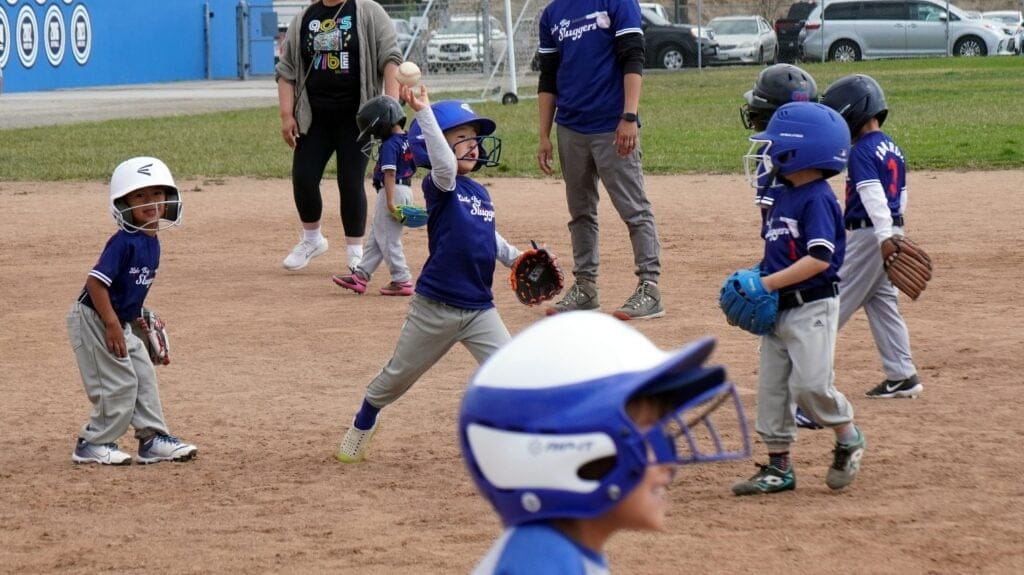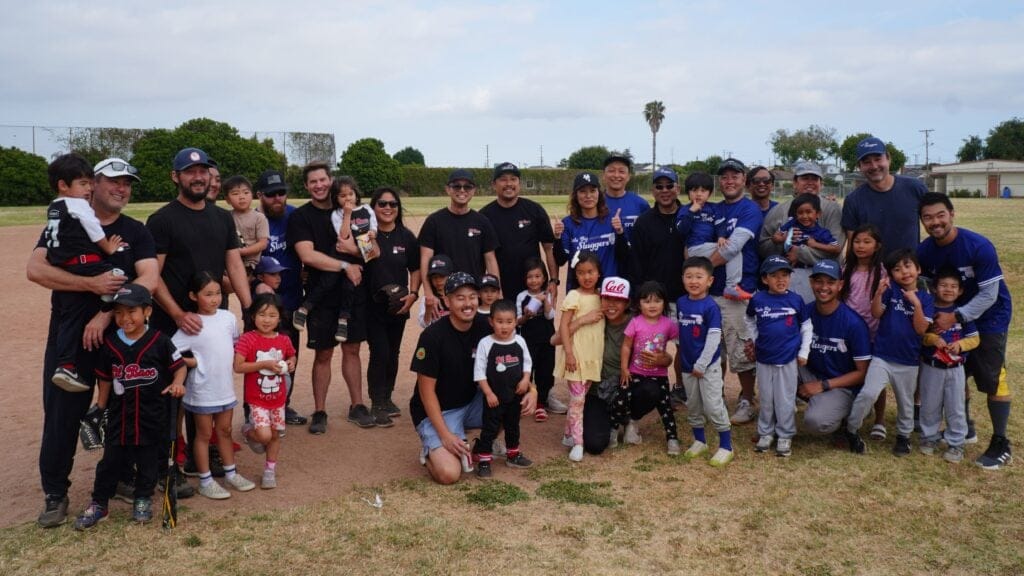Japanese baseball stars playing for the Los Angeles Dodgers have been a boon for Japanese American communities in LA. On game days, business booms in Little Tokyo. Stores are full of baseball star Shohei Ohtani-inspired shirts and postcards.
And the craze is only increasing this year. The Dodgers started the regular season this year as the reigning World Series champs and played their first games of the year at the Tokyo Dome in Japan.
The popularity of Japanese players in major league baseball has trickled down from excited parents to baseball’s youngest fans — some of whom you can find on the fields at North High School in Torrance on a weekend afternoon.
At the youngest age group, the t-ball division, a dozen preschoolers on each team are outfitted in tiny blue or purple baseball jerseys and helmets that make their heads look two sizes too big.
Parents and coaches do their best to position kids on the field in some semblance of a regular baseball game, but it’s mostly chaos.
Get new stories about LA County in your inbox every Sunday
As soon as one kid hits the ball off the t-ball stand, all of the kids break formation and chase the ball, some tripping and falling in the dirt as they run. One young player will manage to pick it up and toss it to the wrong base. And inevitably, a parent will have to go rescue a kid who wandered too far into the outfield.
Welcome to a day in the Sansei League, a local Japanese American youth baseball league for kids aged 4 to 14. League president Jason Murai said that since Ohtani, and star Japanese pitchers Yoshinobu Yamamoto and Roki Sasaki joined the Dodgers, the connection between them and American baseball has brought a renewed interest to the league.
Murai found that name-dropping Ohtani was a good recruiting tactic at his son’s daycare. “When I tried talking to the other parents at the daycare about joining [Sansei League], they said, ‘Oh, Shohei,’” Murai said. “So I think it did give them a little more impetus or excitement into baseball, and I think it helped get some of the kids in.”
 Kids in Sansei League play on a field at North High School in Torrance. Photo courtesy of Nathan Yun.
Kids in Sansei League play on a field at North High School in Torrance. Photo courtesy of Nathan Yun.
LA Public Press reached out to the Dodgers about the players’ impact on the Japanese American community, but did not receive a response.
Even with the recent boost in sign-ups in the past two years, the biggest challenge Sansei League faces is enrollment, which is still significantly down from historic highs. When Murai played in the league as a kid, he said there were about 600 children ranging in age from 4 to 13. Now, there are only about 300 kids.
But Murai is determined to make sure that the league continues to grow, so that other families might have the opportunity to pass on the tradition and love of baseball.
“Every small farm town community had a baseball team”
Japanese Americans have been playing the game for more than a century. Sansei League started in 1960, and archival photos show kids playing on the baseball fields surrounded by farmland. That’s similar to the origins of the first Japanese immigrants to the U.S. who moved to the U.S. to work on farms and learned to play baseball in the early 1900’s.
“Every small farm town community had a baseball team, and that was their way of outreaching to other communities,” explains Kerry Yo Nakagawa, president of the Nisei Baseball Research Project.
Some of the first Japanese American leagues emerged in the early 1900s, when widespread Asian discrimination kept Japanese people from playing on white teams. The Japanese teams were, however, able to play against other segregated teams, like Mexican, Italian, Irish, and Black teams.
Nakagawa estimated that thousands of Japanese people participated in leagues around the world, from Hawaii to Nebraska and Vancouver, Canada, to Tijuana, Mexico. These leagues had different divisions, all the way up to a semi-pro level.
When World War II broke out, Japanese American baseball continued behind barbed wire. Tens of thousands of Japanese American were forced to give up their homes and businesses and moved to incarceration camps in remote areas of the country — including Manzanar in California’s Owens Valley. They built baseball fields at these camps, and games would attract hundreds of spectators. It was a rare glimpse of joy and a reminder of what life was like before internment.
When the war ended, many Japanese American families moved back to Southern California and began to re-establish their community. Sansei League was part of that movement. Sansei refers to the third generation of Japanese families, the grandchildren of the generation that immigrated to the U.S.
But the problem for Sansei League today is that there are fewer and fewer Japanese people in the area to carry on the tradition. The Japanese American community in Torrance has shrunk, by about 20%, from 2010 to 2020, according to U.S. census data. That’s partly because major Japanese companies like Toyota moved away from the area during that time.
Youth sports have also changed a lot in recent decades. Some families want to play in more competitive baseball leagues that give them a chance at playing in the Little League World Series (like the neighboring El Segundo Little League team did in 2023) or prepare kids to play in high school and beyond. Many kids also opt for basketball or other sports instead.
But Sansei League parents and organizers say there’s still a need for the community-based recreational league. Games are played on weekends at North Torrance High School, making it a much less time-intensive activity for families.
“It’s a cute little family” Sansei League players and their families gather for a group photo on the field at North High School in Torrance. Photo courtesy of Nathan Yun.
Sansei League players and their families gather for a group photo on the field at North High School in Torrance. Photo courtesy of Nathan Yun.
The league is very much an intergenerational family affair. On a weekend morning or afternoon on the high school field, you’ll see two or three dozen spectators of all ages: grandparents and parents sitting in the stands, siblings playing behind the bleachers, aunts, uncles and cousins, all gathered in one place. Some people will set up pop-up tents or camping chairs.
The players wear baseball uniforms with team names like “Samurai” or “Musubis.” Twelve-year-old Shota Yoshikawa plays on a team called The Lightning. He says he enjoys it more than his Little League team.
“This is just way more casual, this league, and it’s way more fun,” Yoshikawa said. He said there are no playoffs in the league, no yelling if a player makes an error, and kids get to try all of the fielding positions.
Other young players mentioned they liked getting to practice their baseball skills and seeing their friends every weekend. The kids in the league choose which teams they want to join, so they can play with their friends throughout their entire Sansei League career.
“ It’s a cute little family,” said Wendy Arima, whose son and daughter play on Sansei teams. “A lot of them even play on the same baseball teams and basketball teams.” Wendy grew up playing in Asian American sports leagues as well and said she wanted to give her children the same opportunity.
“I played Sansei Baseball many, many years ago,” said Sansei League commissioner Kevin Arima, who is married to Wendy. “And a lot of the kids that I met through Sansei Baseball ended up becoming lifetime friends.”
Some of the Sansei League alums continue playing in Japanese American baseball leagues as adults, too. Brett Takeuchi, who grew up playing in Sansei League, now plays for a recreational team called the Little Tokyo Beavers.
In October, he also played in the exhibition games of Japanese American teams at a newly reconstructed ball field at Manzanar, where his grandparents were incarcerated. It was the first time a baseball game had been played there since the war.
He described the experience of playing baseball there as surreal. “We have so much history going back with our grandparents, so it’s just an honor being here,” Takeuchi said.
Sansei League will continue to honor the history of Japanese American baseball in its own way as well. It doesn’t just have games on the weekend, it’s also organizing a group outing to a Dodger game to see the kids’ favorite Japanese players and to a Los Angeles Angels game for Japanese Heritage Night.
But perhaps the most exciting games are still the ones at Sansei baseball’s home fields, when the community gets to come together each week to carry on this 125-year-old tradition of Japanese Americans playing baseball.
“Coming back, you see friends you grew up with, and they’re having kids, and your kids are now becoming friends,” Wendy Arima said. “That’s very special, you know? That doesn’t happen everywhere.”
We want to build a newsroom for all of Los Angeles.
But we need your help.


AloJapan.com